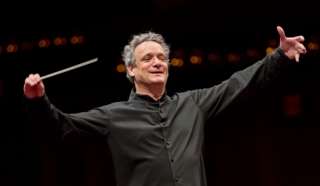|
Back
Mostly Mozart Gets Off To A Dancing Start New York
Avery Fisher Hall, Lincoln Center
07/28/2015 - & July 29, 2015
Wolfgang Amadeus Mozart: Der Schauspieldirektor, K. 486: Overture – Piano Concerto No. 14 in E-flat major, K. 449 – Vorrei spiegarvi, oh Dio, K. 418 – No, che non sei capace, K. 419 – Symphony No. 34 in C Major, K. 338
Erin Morley (Soprano), Emanuel Ax (Piano)
Mostly Mozart Festival Orchestra, Louis Langrée (Conductor)

L. Langrée (© Jennifer Taylor)
Louis Langrée had two opposing ways of introducing this year’s Mostly Mozart Festival. He could have started with the majestic and glorious measures of Mozart’s underrated 34th Symphony. Or he could have chosen a contrapuntally riakld overture to The Impressario, also rarely played.
Mr. Langrée, a delightful conductor who is as animated as his summertime chamber orchestra, opted for the Overture, assuring the audience that this opening night would be an ebullient one.
With two soloists, with the diversity of overture, concerto, concert aria and symphony, with Mozart at the height of his powers, Mr. Langrée obviously was aiming to show what he could do best. This was not “mostly Mozart”, but it was all Mozart, most of which was new to listeners but all of which was bewitching.
The only familiar work, in fact, was played by New York’s most familiar pianist, Emanuel Ax. Familiarity in this case breeds content, for the modest Mr. Ax, shrugging, almost bashfully making his way to the piano, is always a false illusion. Once he started on the 14th Concerto, his innate grace, his filigree touch, and the endless Mozart melodies became a part of the evening’s palette.
The grace was apparent in–wait for it!–Mozart’s opening in three-quarter time, music which danced constantly through the movement, all the way to the cadenza. The second movement was equally ebullient, not so much for the orchestra, but for the translucent tone achieved by Mr. Ax. To anyone else, this would be an elegant Andantino. Mr. Ax turned it into a celebration of sounds. Mr. Ax finished ended with as sprightly an accounting as one would wish in the finale. (And, as a coda, played another waltz, this by Chopin.)
Mr. Langrée did the best he could with his orchestra, but Emanuel Ax inimitably focused all ears.

E. Morley (© Dario Acosta)
The other soloist, after the intermission, was one of the Metropolitan Opera’s newest stars, and she gave operatic input to a pair severely difficult bel canto arias. They had been written as insertions for another composer’s opera (Mozart was apt tohide his show-off qualities by a presumed gift of kindness). He had written it for a singer he absolutely adored, as women and soprano. And while he lost out in the romantic side (having to marry Aloysia Lange’s sister), her voice must have been a wonder of the 18th Century.
In fact, both arias were obvious precursors of Magic Flute’s Queen of the Night, premiered by the same soprano. Fearful runs up the scale, great leaps up to a high E above the staff, and even changes in dramatic mood.
Erin Morley was up to the task, though one feels she was giving German weight to these Italian feather-light lines. Yes, the roles are dramatic ones, and her soaring notes–especially in the duet with oboist Randall Ellis–were right on target. But the drama, rather than the exercises were fit for 19th Century opera.
The bookend works took the Mostly Mozart Festival Orchestra into unknown ebullient spheres. One would have thought the short Impresario would be a plot–a backstage bickering during an opera rehearsal–into the spheres of Richard Strauss. But this Overture was a glittering opening, those contrapuntal lines at the end, as transparent as the finale of the “Jupiter.”
And now to the 34th Symphony, which, had I don’t recall hearing previously. Which was fine, since it was new to me, and I loved it. This was Mozart who seemed to imitate Haydn. The ceremonial opening (with lots of trumpets and horns, the first time the orchestra appeared in full) with little jokes. Sudden single-measure forays into a minor key, abrupt changes of meter, woodwinds in Elysian thirds. And then the second movement which had equally Haydnesque, the single bassoon playing against a delicious string orchestra.
The finale was another romp. One hates to put together a “personal” mood with a musical emotion, but one thinks that Mozart must have been playing with his bird, enjoying the Salzburg weather and even enjoying a few lagers with his wife.
Oh, the third movement? He wrote only 14 bars and then stopped. The orchestra did the same, the conductor Langrée explained to the audience, “We have no idea why he didn’t continue.”
Well, I know. With these three movements, Mozart had no regrets at unalloyed happiness. “Why,” (he might have pondered) “do I need a lightweight minuet, when the everything else is already dancing?”
Harry Rolnick
|